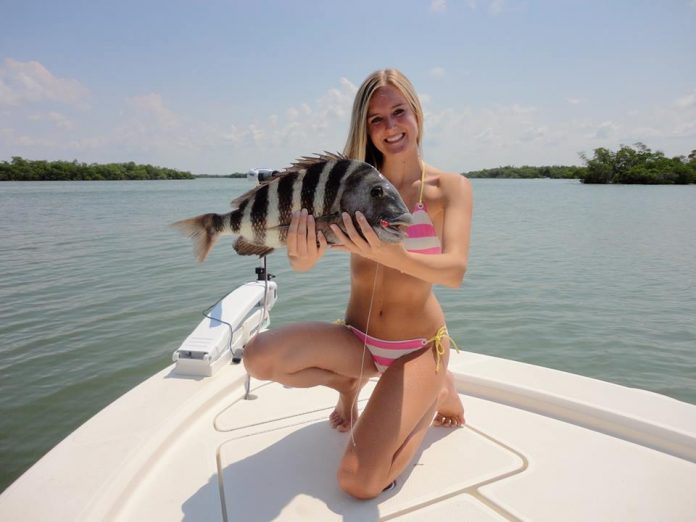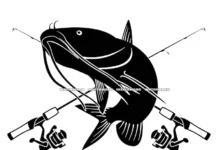February 11, 2010 By Neil Taylor
Weather got you down? Trying to decide if you should venture out at all with this never-ending El Nino winter? Don’t sit inside and fret, go fishing anyway! Throughout much of the state of Florida you can consider targeting the striped bandit. A sheepshead outing can be done on days where other types of fishing would be a lot tougher to do. Sheltered areas like the canals and some passes and bridges can be accessed and lead to great action. Sheepshead are great sport and excellent table fare if properly prepared.
The situation is very simple: Sheepshead chew on rocks for a living. They love barnacles, fiddler crabs, sand fleas and shrimp but will also eat a bloodworm and even an earthworm. While you may run into sheepshead on the “flats” where you’d also find redfish, your odds are a lot better fishing physical “structure.” Bridge pilings, residential docks, rockpiles, oyster bars or “wrecks” are ideal locations to find these fish in the porgy family. If you are where there are crustaceous barnacle coated things, you are probably also where there are sheepshead.

The time of year is perfect for targeting this species. “Control” your bait-of-choice as it sinks down to the fish, preventing from fouling on a rock or other structure. The amount of weight you use will depend on the situation. As a rule-of-thumb, use the minimum amount of weight to get the bait down to where the fish should be. Deeper water and/or higher current will obviously require more weight. If possible “split shot” it, using minimal weight, anglers have little trouble feeling the fish take the bait. For fishing docks that aren’t extremely deep, set up a little farther away from that structure. The deeper the situation, the closer you can consider fishing from the location of those fish.
Tackle up with a 1/0 mosquito hook or circle hook, 20-pound fluorocarbon leader and a rod that you like the “feel” of the outfit. Set the hook or just start reeling fast when you feel weight load up to the rod tip as a sheepshead starts swimming away with the bait. Once hooked, they’ll put up a good fight but you shouldn’t lose a lot of these fish. Be aggressive and place baits right on the structure. Observant anglers will notice that “bridge sheepie” anglers will lean over the side and have the rod tip angle straight down. This is to keep a bait right up against a piling. Keeping a bait against rocks, a piling or oyster bed means that they will find it. Baits that are any distance away from the structure will often not get their attention.
You bet your life: There will be convicts right up against these pilings!
Targeting the very biggest sheepshead is similar to other kinds of fishing. A larger bait can pay off with the “fish of a lifetime”. In years past, I’ve caught the largest sheepshead by dropping a large live shrimp with the tail pinched off. With no tail to allow them to evade attackers, the bait will have the right presentation. With a larger shrimp, the smaller to medium sized sheepshead may have to defer to the loner brute that’s eyes light up when it sees that bait. Bring a landing net with you: The very largest sheepshead may be too heavy to lift into the boat without the line breaking!
You’ve captured and iced down your quarry. You’ve heard that sheepshead are a nightmare to fillet? As with other fish, this is true with the very first experience but gets much easier once you have the “know how.” Filleting of a sheepshead should be done with caution. There are multiple hazards that exist in the process. Always cut “away from the hands” when filleting any fish. A sheepshead has thick scales and the knife tip can slip and cause injury if the other hand is in that direction. The second hazard is the spines on top of the fish. Be careful when handling the fish and avoid getting spiked by one of these daggers. Two great fillets come off the fish. Flip the skin side down and shave the meat off the skin. The final step in preparation before “chunking” the fish for cooking: Cut a “V” section out of the center of each fillet, removing a line of tiny bones. “Chunking” is cutting the remaining meat into bite-size pieces before cooking the meat.

My personal preference for sheepshead is-dipped in egg whites, rolled in flour and then thrown into hot olive oil on the stove top”. Flip them over a couple of times and remove them when the coating is a golden brown. Squeeze on a little lemon juice or just eat them as they are, you will look forward to enjoying catching, and eating, sheepshead in the years to come.

- The Neil Blog… - July 26, 2023
- The Catfish - July 26, 2023
- update - July 22, 2023











